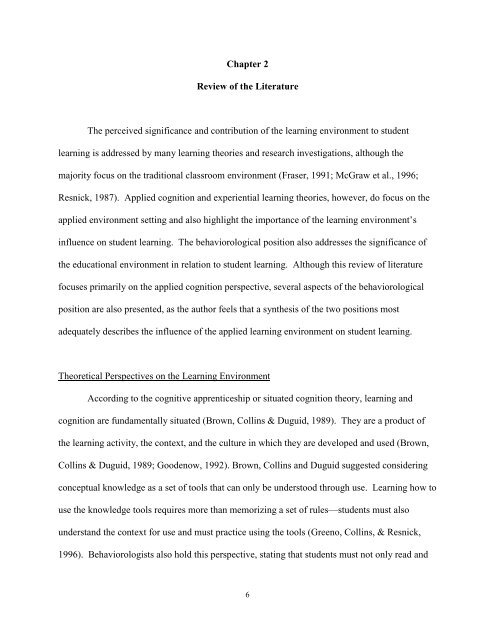STUDENT EVALUATION OF CLINICAL EDUCATION ENVIRONMENT
STUDENT EVALUATION OF CLINICAL EDUCATION ENVIRONMENT
STUDENT EVALUATION OF CLINICAL EDUCATION ENVIRONMENT
You also want an ePaper? Increase the reach of your titles
YUMPU automatically turns print PDFs into web optimized ePapers that Google loves.
Chapter 2<br />
Review of the Literature<br />
The perceived significance and contribution of the learning environment to student<br />
learning is addressed by many learning theories and research investigations, although the<br />
majority focus on the traditional classroom environment (Fraser, 1991; McGraw et al., 1996;<br />
Resnick, 1987). Applied cognition and experiential learning theories, however, do focus on the<br />
applied environment setting and also highlight the importance of the learning environment’s<br />
influence on student learning. The behaviorological position also addresses the significance of<br />
the educational environment in relation to student learning. Although this review of literature<br />
focuses primarily on the applied cognition perspective, several aspects of the behaviorological<br />
position are also presented, as the author feels that a synthesis of the two positions most<br />
adequately describes the influence of the applied learning environment on student learning.<br />
Theoretical Perspectives on the Learning Environment<br />
According to the cognitive apprenticeship or situated cognition theory, learning and<br />
cognition are fundamentally situated (Brown, Collins & Duguid, 1989). They are a product of<br />
the learning activity, the context, and the culture in which they are developed and used (Brown,<br />
Collins & Duguid, 1989; Goodenow, 1992). Brown, Collins and Duguid suggested considering<br />
conceptual knowledge as a set of tools that can only be understood through use. Learning how to<br />
use the knowledge tools requires more than memorizing a set of rules—students must also<br />
understand the context for use and must practice using the tools (Greeno, Collins, & Resnick,<br />
1996). Behaviorologists also hold this perspective, stating that students must not only read and<br />
6












